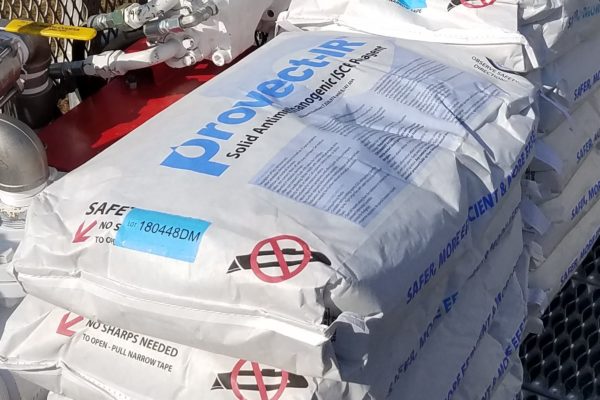AquaBlok-CH4™ Technology for Inhibiting Methanogenesis during In Situ Sediment Treatment
Third International Symposium on Bioremediation and Sustainable Environmental Technologies | May 18-21, 2015 | Miami, Florida
By John Hull (AquaBlok, Ltd.) and Jim Mueller (Provectus Environmental Products, Inc)
Problem: In situ sediment capping remediation systems mitigate the migration of contaminants through sediments. Two generalized approaches are: (1) passive capping, which is the deployment of a barrier material that is relatively impermeable to both the water above and the contaminants below; and (2) active/reactive capping, which employs one or more additives or amendments to a relatively permeable barrier in an effort to bind up and/or destroy the contaminants as they migrate through the treatment area. One resulting complication of any sediment capping action or the addition of reactive agents is that the implementation/construction processes themselves typically create an initial spike of methanogenic activity because the sediment becomes disturbed and available carbon sources are more rapidly consumed. A second methane spike can occur later as oxygen is depleted from the remediated site, thus shifting the balance between aerobic biodegradation and anaerobic biodegradation in favor of methanogens. The production of methane is problematic from several perspectives, including: i) stimulation of anaerobic microbial activity can lead to methylation of mercury and other heavy metals, with many negative consequences, and; ii) the production of methane can create gas bubbles (ebullition) which can transport contaminants via surface tension phenomena through localized cap failures due to gas buildup, and sometimes produce a toxic sheen at the water surface.
Approach: AquaBlok™ technology supports the uniform and targeted placement of high-value/low concentration treatment amendments in sub-aqueous environments. These materials can be formulated with various remedial amendments to meet site-specific needs. For example, Provect-IR™ combines controlled-release particulate carbon material and micro-scale zero valent iron (ZVI) or other metals to yield in situ chemical reduction (ISCR). Provect-IRM™ is similar in composition, but it is designed to immobilize metals and other inorganic contaminants. Uniquely, these amendments also contain a number of natural statin compounds, including Monacolin K (also known as Lovastatin), that effectively inhibit methanogens while permitting other biodegradation processes to occur. AquaBlok-CH4™ offers the combined advantages of both technologies (Hull and Mueller, 2014). As described herein, the resulting cap will simultaneously treat contaminants while controlling methane production which manages several problems common to in situ sediment capping systems, namely: i) reduced ebullition of gases; and ii) reduced methylation of heavy metals
Results: The presentation will provide an overview and update of current thin capping concepts and other subaqueous technology applications utilizing variable permeability materials. Data and modeling will be presented to support active capping designs / in situ funnel-and-gate systems for sediments illustrating the ability to perform treatment of subaqueous contaminants below a cap. For example, treatment of arsenic in an AquaBlok-CH4 zone involves the reduction of adsorbed arsenate [As(V)] anions to arsenite [As(III)] coupled with their long-term sequestration as solid arsenic species by means of reductive precipitation and adsorption onto the iron corrosion products.
Proposed Session:
Application of Bioremediation to Complex Sites: Session 3b: Bioremediation of Sediments
Corresponding Author:
Jim Mueller – Provectus Environmental Products, Inc.,
2871 West Forest Rd, Suite 2 | Freeport, IL 61032
Phone: (815) 650-2230
Email: [email protected]
Coauthors:
John Hull – AquaBlok, Ltd.
3401 Glendale Ave – Suite 300
Toledo, OH 43614
(419) 385-2980

